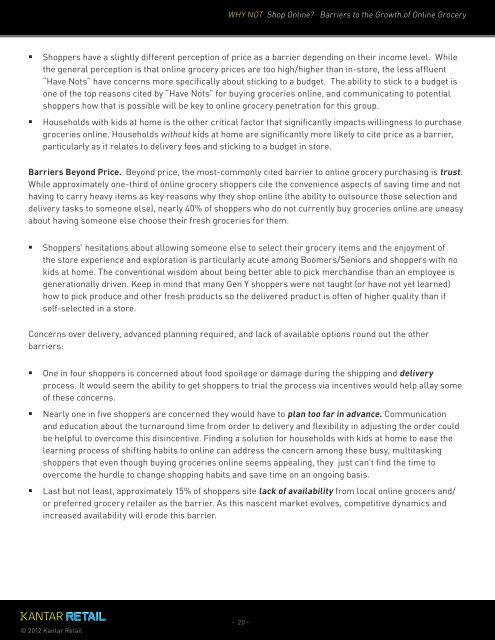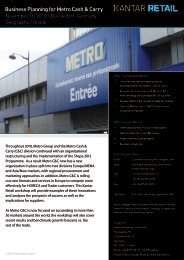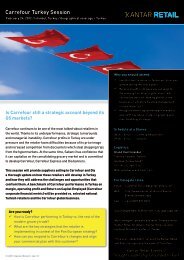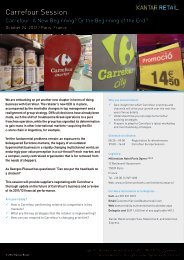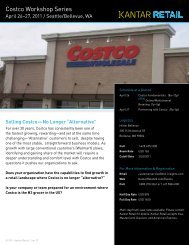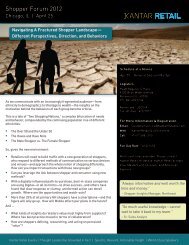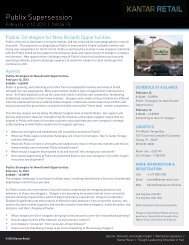The Future of Online Grocery Shopping in the United ... - Kantar Retail
The Future of Online Grocery Shopping in the United ... - Kantar Retail
The Future of Online Grocery Shopping in the United ... - Kantar Retail
You also want an ePaper? Increase the reach of your titles
YUMPU automatically turns print PDFs into web optimized ePapers that Google loves.
© 2012 <strong>Kantar</strong> <strong>Retail</strong><br />
WHY NOT Shop <strong>Onl<strong>in</strong>e</strong>? Barriers to <strong>the</strong> Growth <strong>of</strong> <strong>Onl<strong>in</strong>e</strong> <strong>Grocery</strong><br />
Shoppers have a slightly different perception <strong>of</strong> price as a barrier depend<strong>in</strong>g on <strong>the</strong>ir <strong>in</strong>come level. While<br />
<strong>the</strong> general perception is that onl<strong>in</strong>e grocery prices are too high/higher than <strong>in</strong>-store, <strong>the</strong> less affluent<br />
“Have Nots” have concerns more specifically about stick<strong>in</strong>g to a budget. <strong>The</strong> ability to stick to a budget is<br />
one <strong>of</strong> <strong>the</strong> top reasons cited by “Have Nots” for buy<strong>in</strong>g groceries onl<strong>in</strong>e, and communicat<strong>in</strong>g to potential<br />
shoppers how that is possible will be key to onl<strong>in</strong>e grocery penetration for this group.<br />
Households with kids at home is <strong>the</strong> o<strong>the</strong>r critical factor that significantly impacts will<strong>in</strong>gness to purchase<br />
groceries onl<strong>in</strong>e. Households without kids at home are significantly more likely to cite price as a barrier,<br />
particularly as it relates to delivery fees and stick<strong>in</strong>g to a budget <strong>in</strong> store.<br />
Barriers Beyond Price. Beyond price, <strong>the</strong> most-commonly cited barrier to onl<strong>in</strong>e grocery purchas<strong>in</strong>g is trust.<br />
While approximately one-third <strong>of</strong> onl<strong>in</strong>e grocery shoppers cite <strong>the</strong> convenience aspects <strong>of</strong> sav<strong>in</strong>g time and not<br />
hav<strong>in</strong>g to carry heavy items as key reasons why <strong>the</strong>y shop onl<strong>in</strong>e (<strong>the</strong> ability to outsource those selection and<br />
delivery tasks to someone else), nearly 40% <strong>of</strong> shoppers who do not currently buy groceries onl<strong>in</strong>e are uneasy<br />
about hav<strong>in</strong>g someone else choose <strong>the</strong>ir fresh groceries for <strong>the</strong>m.<br />
Shoppers’ hesitations about allow<strong>in</strong>g someone else to select <strong>the</strong>ir grocery items and <strong>the</strong> enjoyment <strong>of</strong><br />
<strong>the</strong> store experience and exploration is particularly acute among Boomers/Seniors and shoppers with no<br />
kids at home. <strong>The</strong> conventional wisdom about be<strong>in</strong>g better able to pick merchandise than an employee is<br />
generationally driven. Keep <strong>in</strong> m<strong>in</strong>d that many Gen Y shoppers were not taught (or have not yet learned)<br />
how to pick produce and o<strong>the</strong>r fresh products so <strong>the</strong> delivered product is <strong>of</strong>ten <strong>of</strong> higher quality than if<br />
self-selected <strong>in</strong> a store.<br />
Concerns over delivery, advanced plann<strong>in</strong>g required, and lack <strong>of</strong> available options round out <strong>the</strong> o<strong>the</strong>r<br />
barriers:<br />
One <strong>in</strong> four shoppers is concerned about food spoilage or damage dur<strong>in</strong>g <strong>the</strong> shipp<strong>in</strong>g and delivery<br />
process. It would seem <strong>the</strong> ability to get shoppers to trial <strong>the</strong> process via <strong>in</strong>centives would help allay some<br />
<strong>of</strong> <strong>the</strong>se concerns.<br />
Nearly one <strong>in</strong> five shoppers are concerned <strong>the</strong>y would have to plan too far <strong>in</strong> advance. Communication<br />
and education about <strong>the</strong> turnaround time from order to delivery and flexibility <strong>in</strong> adjust<strong>in</strong>g <strong>the</strong> order could<br />
be helpful to overcome this dis<strong>in</strong>centive. F<strong>in</strong>d<strong>in</strong>g a solution for households with kids at home to ease <strong>the</strong><br />
learn<strong>in</strong>g process <strong>of</strong> shift<strong>in</strong>g habits to onl<strong>in</strong>e can address <strong>the</strong> concern among <strong>the</strong>se busy, multitask<strong>in</strong>g<br />
shoppers that even though buy<strong>in</strong>g groceries onl<strong>in</strong>e seems appeal<strong>in</strong>g, <strong>the</strong>y just can’t f<strong>in</strong>d <strong>the</strong> time to<br />
overcome <strong>the</strong> hurdle to change shopp<strong>in</strong>g habits and save time on an ongo<strong>in</strong>g basis.<br />
Last but not least, approximately 15% <strong>of</strong> shoppers site lack <strong>of</strong> availability from local onl<strong>in</strong>e grocers and/<br />
or preferred grocery retailer as <strong>the</strong> barrier. As this nascent market evolves, competitive dynamics and<br />
<strong>in</strong>creased availability will erode this barrier.<br />
- 20 -


